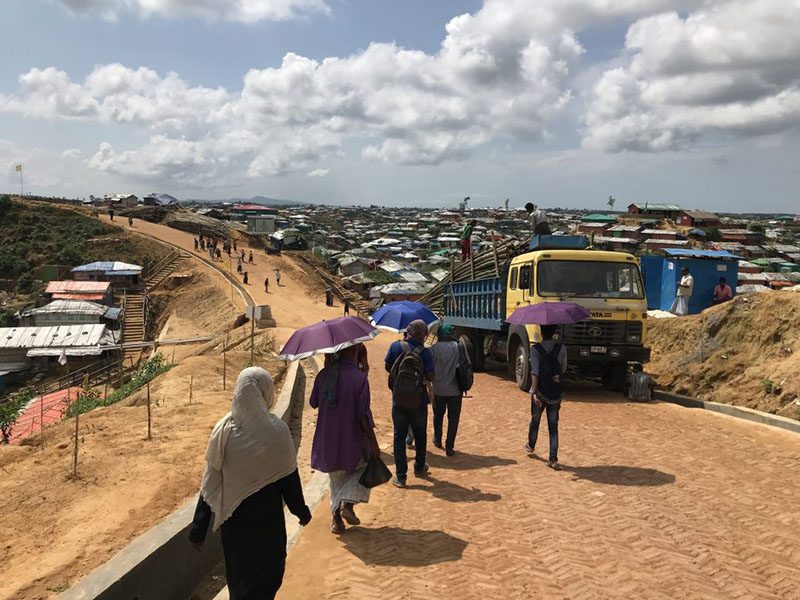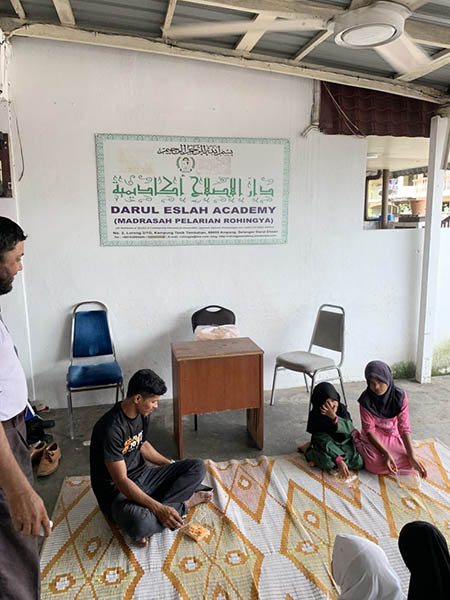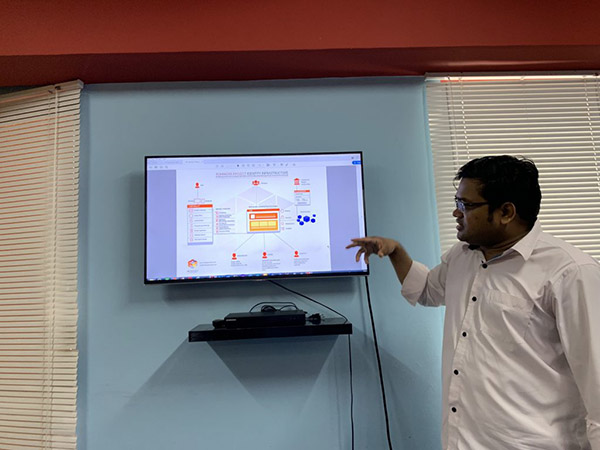While Myanmar’s recent ethnic cleansing of its Rohingya minority, which saw 800,000 people driven into Bangladesh, has brought the community’s oppression to the world’s attention, it has also masked a longer term project of exclusion in which the state has been denying the Rohingya their ethnic name and forcing them from their homes since the 1970s.

Figure 1: 29 September 2018 Cox’s Bazar refugee camps
Not only are there now more Rohingya living outside Myanmar than within, but entire generations are being brought up in exile. Critically, many host communities institute ambiguous regimes of il/legality, defined by intertwining inclusions and prohibitions, which keep Rohingya in perpetual limbo, caught between integration and expulsion.
A Rohingya-led NGO based in Kuala Lumpur (KL), has proposed a novel, even radical, solution: to use blockchain, the technology that enables cryptocurrencies such as Bitcoin, to circumvent the state exclusion that has long put things such as bank accounts out of reach for Rohingya. At first glance this sounds farfetched, even absurd. But the Rohingya Project (RP) is not suggesting that Rohingya speculate in volatile crypto markets. Rather, it proposes to create an assemblage out of blockchain, biometrics, and fin-tech to generate new forms of both individual and collective subjectivity, enabling Rohingya to take control of their identities and futures. This vision, in its ambition to attain nothing less than the transformation of Rohingya from largely invisible stateless individuals to new juridico-economic subjects, goes beyond techno whimsy. It also introduces the sobering risk fundamental to improvising with new technologies on some of the world’s most marginalized people.

Figure 2: Rohingya community-based organizations provide the only education stateless children can access [16 April 2019]
Down and Out in KL, Forever?
Malaysia, one of the countries in which I have been conducting research on Rohingya lives, has become the home to 200,000 Rohingya over the past three decades. After years of harsh immigration policies, recent reforms—precipitated by empathy in relation to the intensification of the ethnic cleansing in Myanmar—have produced a tacit Malaysian state policy in which the Rohingya are permitted to reside in the country. However, the mechanism enacted by the United Nations refugee organization (UNHCR) for discerning ‘real’ Rohingya from other ‘illegal immigrants’ is beset with flaws, resource shortages, and even corruption. Moreover, even if a Rohingya attains the coveted UNHCR card, this affords them no resources, and as they still remain illegal according to the law, harassment at the hands of state security forces persists. More importantly, this illegality means the Rohingya are also prohibited from employment and education. Employers hence exploit Rohingya laborers, most of whom toil in low value-added sectors such as fish processing or construction, forcing them to accept wages far below the market rate. Rohingya children are barred from education, meaning that they risk reproducing their parents’ marginalized labor position.
Rohingya NGOs have emerged to attempt to redress these exclusions. Dozens of learning centers have sprouted up to provide informal education. Others deliver local development initiatives, such as urban farming or mosque cleaning. But there is a pervading sense, given the structural exclusion of the Rohingya, that these initiatives merely manage perpetual exclusion. Muhammed Noor, the head of RP—an organization that began as Rohingya media service R-Vision amongst other initiatives—expands on the relationship between legal exclusion and persistent socio-economic marginalization:
“Here Rohingya are manual laborers. But it’s not today laboring and then soon they are managing. There is no improvement…because they don’t have documents, they can’t open shops; can’t own transport; can’t have bank accounts. They are stuck in this circle.”
While the Myanmar state has denied the Rohingya their name, Noor here suggests that the lack of identity has deeper ramifications: a life of interminable marginalization, passed on from one generation to the next. The critical intervention RP is proposing involves nothing less than a transformation in the politico-legal status of Rohingya life itself. But how, in a world of states that retain the sovereign prerogative to dictate belonging, can the Rohingya traverse the threshold of exclusion?
Blockchaining as chain breaking?
As demonstrated by the uselessness of the UNHCR card, RP stresses that the central problem is not identity per se, as being recognized as Rohingya is simply a way of giving a name to their continuous omission from society. Rather, any identity project must be instrumental in materially altering life opportunities.
As Noor suggests above, one way to achieve such a transformation is to allow the stateless to obtain bank accounts. But post-9/11 revisions to international financial law, in which financial flows have been securitized to prevent ‘material support’ to what dominant states perceive are malignant actors, have meant that the stateless often cannot access bank accounts. This is because as knowledge about the recipients of finance has been intensified, expressed in so-called “Know Your Customer” (KYC) protocols, banks comply by simply relying on state knowledge apparatuses (citizenship identification). Those without ID, such as the stateless, are effectively barred. However, as a University of Washington study for RP shows, the statutes make an exception when individual’s biometric data—an encrypted iris scan, for instance—can be used to confirm their identity. This is where blockchain comes in.

Muhammed Noor diagrams RP’s blockchain visions (15 April 2019]
Blockchain operates as a ledger sequentially recording transactions, block by block, as it were. But whereas centralized ledgers sequester information within virtual walls, blockchain’s architecture turns the structure inside-out, distributing data across the potentially infinite nodes composing the network. The entire chain—every transaction—is replicated on every node, constituting a horizontal system that has no center to hack. Proponents hence argue that blockchained data are impregnable and immutable—as any single violated node would, by dint of its incongruity with the rest, be identified and rejected.
The radical possibility lies in the way the biometric-blockchain assemblage seeks to simultaneously provide Rohingyas with evidence of their existence—by iteratively constituting their identity with each additional transaction recorded—even as that new identity becomes that which constitutes the platform for accessing new opportunities (bank accounts, loans, etc.), transforming the trajectories of that existence. And while ‘financial inclusion’ itself is hardly sufficient for changing lives—studies across the world have shown it can leave vulnerable people more exploited, as they take on debt they cannot repay—the vision here transcends the economic. Indeed, RP sees the records of asset transfers, investments, loans and loan repayments, and bank accounts, linked with encrypted bio-data, as turning Rohingya into bodies that matter, bodies whose material existence is, counterintuitively, substantiated by these virtual inscriptions. This would allow them particular forms of recognition and visibility—to transnational institutions—even as it allows them to evade an undesired legibility (of the Malaysian security forces).
Further still, even as they seek to transform their legal personhood, they would build a deterritorialized Rohingya nation as well, bound together by the network they have co-constituted: as opposed to being ‘centralized’ (and hence vulnerable to destruction) in Myanmar, they would, in mimesis with the blockchain infrastructure itself, find protection in their distribution across space.
Hence, while the disruptive potential of blockchain may be overblown when we consider how it merely intensifies the ways that bourgeois Northern subjects are enmeshed into systems of surveillant capitalism (it is telling that ‘middle-men’ such as banks, meant to have been displaced by the blockchain revolution, are now some of its biggest proponents), for the Rohingya both the opportunities and conceivable risks are markedly greater.
If They See You
Questions about the practical feasibility of this plan abound, of course. Will banks find Rohingyas to be loan-worthy? If so, will Malaysia accept a micro-economy sprouting at its margins, or will its emergence risk undermining the current arrangement in which Rohingya enjoy temporary refuge? More concerning still are questions about the political and personal consequences for those Rohingya who might participate: will unanticipated technological developments or mismanagement expose the Rohingya to data breaches, as some have warned? Will the digital intermediation, rather than fostering new forms of sociality, leave Rohingya individuated and atomized, both separating them from one another and undermining political mobilization for, say, justice in Myanmar?
These problems are all vexing. It is tempting to dismiss the entire project as a mere techno-governance dream that ignores the political structures that have produced and maintained the Rohingyas’ marginalized position. But I want to suggest that this is a phenomenon in which the solution appears distasteful not only because it advances a problematic ‘solution’ (blockchain and financial inclusion), but because it punctures the fantasy that a desirable solution will ever actually be effected. The technological intervention implies it is a fool’s errand to wait for the inter-state political system (of ‘international law’ and the human rights regime) to finally address this problem. It suggests that as Malaysia remains uncommitted to integrating the Rohingya, Myanmar intractable in its racism, the United Nations impotent, and the ‘international community’ fragmented and indifferent, any such a ‘solution’ will remain forever deferred.
For the Rohingya in both Malaysia and beyond, the blockchain produces a line of flight that is perilous and brittle; it is obscene that the Rohingya are compelled to ride it at all. On the other hand, it produces a fantastic imaginary: that Rohingya can cross the threshold out of the zone of anomie and into the realm of symbolic recognition through the combination of the immutability of biometrics, the durability of blockchain, and the transformative power of financial inclusion. It seems necessary, therefore, to both retain a critical eye when considering such projects, and assess them from the perspective of those who might use them to transform their lives, thereby deconstructing the binary dividing techno-optimists from critics to perceive how the tech fantasy throws light on the political assemblage within which it is conjured.

1 Trackback